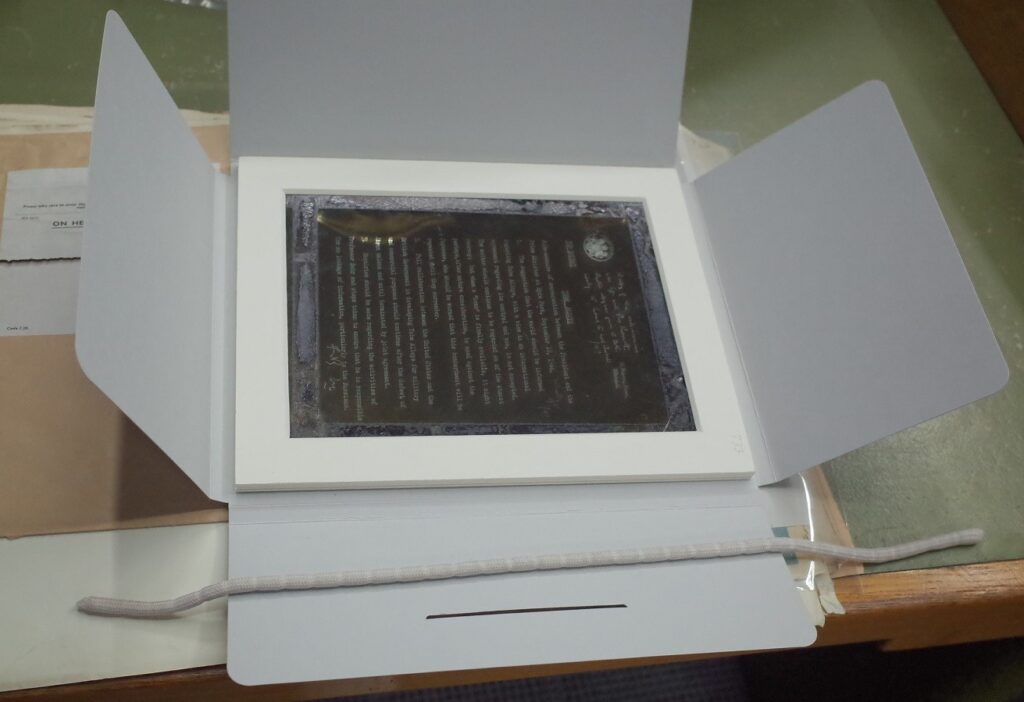私は2022年 4 月に広島平和研究所に着任しました。研究テーマとしているのは、核兵器をめぐるアメリカの対外関係や国際関係の歴史です。
核兵器をめぐる歴史の研究は、政策立案にとっての含意をもたらします。その一つの例を挙げてみますと、核兵器使用の威嚇が朝鮮戦争の休戦交渉に与えた影響についての歴史研究があります。行き詰まっていた朝鮮戦争の休戦交渉が1953年 7 月にまとまったのは、アメリカが核兵器を使用する可能性を前面に出して中国を威嚇した結果、中国側から譲歩を引き出すことができたからだ、とする見解を当時アメリカ大統領だったアイゼンハワーがのちに表明しました。けれどもそのような見解に対して、ローズマリー・フットによる研究に代表される歴史研究は、元大統領が示した見解が実際の事実関係と一致しないことを明らかにしました(Rosemary Foot, A Substitute for Victory: The Politics of Peacemaking at the Korean Armistice Talks. Ithaca: Cornell University Press,1990)。そのような歴史研究の成果がもつ含意は、朝鮮戦争の休戦交渉の過程からは核兵器使用の威嚇が外交政策の手段として有効であるかどうかは明らかにならない、というものでした。
核兵器をめぐる歴史の研究においても一次資料が大きな重みをもっています。一次資料を閲覧していると驚くことがあります。私の記憶に新しいのは、2019年のイギリス国立公文書館(写真1)での驚きでした。その一つは、1944年 9 月にチャーチル・イギリス首相とローズヴェルト・アメリカ大統領が原爆・原子力開発や原爆の対日使用について合意した「ハイドパーク覚書」の 2 カ所に手書きで註の書き込みがあるのを見た時のことでした(写真2。PREM3/139/11A, the UK National Archives in Kew, London)。私がその時までに目にしていたアメリカ国務省が刊行したアメリカ外交文書集は、同覚書のオリジナルの紙版にある書き込みについて記していました。また私は、それら 2 カ所の書き込みがないローズヴェルト大統領図書館が所蔵する同覚書の写真複写版をすでに見ていました。それにもかかわらず、あるいは、そうであったので、イギリス国立公文書館で私が閲覧したものには註の書き込みがあることに息をのんだわけです。それに続いてさらに驚いたのは、それらの書き込みを消すことなくその紙版の覚書をそのまま写し取って、白色と黒色を逆転させたネガティヴ仕様に仕立てた同覚書のガラス判すら同館が所蔵していたことでした(写真3。同上)。このような驚きを味わえるところにも、研究の醍醐味はあるのでしょう。
さて、核兵器をめぐる歴史を研究していく上には、いくつかの問題が立ちはだかっています。その一つが、安全保障上の理由から核兵器に関する資料の公開に制限がかけられていることです。日本がアメリカの核兵器戦略と関係するようになっていった経緯を研究していた2012年に私が出くわしたその実例が写真4です。
写真4の文書は、アメリカ連邦議会図書館で閲覧したフォルダーの中にあるはずの資料の代わりにそこにあった、その資料を非公開としていることを記した文書です(B30775Folder, Box 204, the Papers of Curtis E. LeMay, Library of Congress, Washington,D.C.)。私が閲覧できなかったこの資料は、その時私が研究していた問題の解明へとつながる資料だったかもしれません。そうであったとすれば、このような資料公開の制限は研究を妨げたことになります。
もう一つの核兵器をめぐる歴史を研究していく上での問題は、方法論にかかわる問題です。核兵器をめぐる歴史についての重要な問いに、実験を目的として爆発させた場合を除いては1945年 8 月以来、誰も核兵器を使用していないのはなぜか、という問いがあります。実際に起こったわけではない出来事について、それが起こっていない原因を明らかにするのは、簡単なことではありません。なぜならば、起こった出来事の原因を明らかにするのとは違い、あることが起こらなかったことに説得的な説明を与えるための適切な方法を用いることが難しいからです。
核兵器をめぐる歴史の研究にはこのような困難がありますが、他の研究活動と同じように、新しい発想や知見を得られる楽しさは他に代えがたいものです。
 イギリス国立公文書館 傾き修正すみ-1.jpg)
(2019年9月21日山田撮影)

(イギリス国立公文書館所蔵、2019年9月26日山田撮影)
ハイドパーク覚書 イギリス国立公文書館所蔵-766x1024.jpg)
(イギリス国立公文書館所蔵、2019年9月26日山田撮影)
-1953年10月10日付け文書についての非公開通知 B30775-Folder-Box-204-LeMay-Papers-LC.-rotated.jpg)
(アメリ連邦議会図書館所蔵)にある非公開通知文書(2019年9月22日山田撮影)
Research on the Diplomatic History over Nuclear Weapons
Yasuhiro Yamada(Professor)
I became a faculty member of the Hiroshima Peace Institute in April 2022. I specialize in the contemporary history of U.S. foreign relations, focusing on the history of U.S. foreign relations concerning nuclear weapons.
Studies of history related to nuclear weapons have implications for policy planning. One example is a historical study concerning the impact of the threat of using a nuclear weapon on the cease-fire negotiations of the Korean War. Regarding the background of the negotiations, Eisenhower, who was then the president of the United States, announced that even though armistice talks once had been deadlocked, both parties reached an agreement in July 1953 because the United States threatened China by suggesting the possible use of nuclear weapons. Historical studies, particularly one by Rosemary Foot, however, revealed that the comment by the former president did not correspond to the facts. (Rosemary Foot, A Substitute for Victory: The Politics of Peacemaking at the Korean Armistice Talks. Ithaca: Cornell University Press, 1990). As indicated in this case, historical studies of the armistice talks of the Korean War do not prove the effectiveness of threatening a negotiation partner with the possible use of nuclear weapons as a means of diplomatic policies.
In historical studies of nuclear weapons, primary sources are of great significance. I have a few experiences of being surprised while observing primary sources. To show a recent case, when I was looking at the Hyde Park aide-mémoire, September 18, 1944 at the UK National Archives (Photo 1) in 2019, I was astonished to find two hand-written notes (Photo 2. PREM 3/139/11A, the UK National Archives in Kew, London). The Hyde Park aide-mémoire is the agreement of September 1944 between then the U.S. President Roosevelt and the then British Prime Minister Churchill on the development of an atomic bomb and nuclear power and use of an atomic bomb against Japan. By that time, I had already read the Foreign Relations of the United States, issued by the U.S. Department of State, which indicated the presence of writing in the margin on the original hard copy. Additionally, I had also observed the photocopy of the Hyde Park aide-mémoire without the writings, which was in the custody of the Franklin D. Roosevelt Library. Despite these facts, I was utterly astonished to see the hand-written notes at the UK National Archives. Paradoxically, it was a breathtaking experience for me probably because I had already known of the presence of the writings. I was even more surprised when I found a glass copy of the aide-mémoire (Photo 3. ditto) in another file. The glass copy featured a negative image with black and white reversed, but the written notes remained there without being erased. Such surprising experiences made me feel the real thrill of research activities.
There are a few challenges in the studies of history related to nuclear weapons. One of the challenges concerns the limited access to related materials due to security concerns. In 2012, when I was studying the process by which Japan became involved in the U.S. nuclear strategies, I found the papers of Curtis LeMay (Photo 4).
When I was looking for a certain document in a folder at the Library of Congress, instead of the item, I found a sheet of paper indicating that the item I was looking for remained classified (Photo 4: B30775 Folder, Box 204, the Papers of Curtis E. LeMay, Library of Congress, Washington, D.C.). The material that I was unable to see probably contained information that would help me clarify my research question. If so, the non-disclosure of the material interfered with my studies.
Another challenge in historical studies concerning nuclear weapons is related to methodology. An important question in the related history is why nuclear weapons have not been used since August 1945, except for their explosions in testing programs. It is never easy to clarify why something did not happen. While it is relatively easy to show reasons why some event happened, it is difficult to offer persuasive explanations for something that did not happen since there are few appropriate methods to be used for this purpose.
Although there are various challenges in studying the history related to nuclear weapons, the moment I encounter new ideas and findings, I feel an overwhelming enjoyment just as researchers in other fields do.
 イギリス国立公文書館 傾き修正すみ-1.jpg)
ハイドパーク覚書 ガラス判 イギリス国立公文書館所蔵-1.jpg)
ハイドパーク覚書 イギリス国立公文書館所蔵-766x1024.jpg)
-1953年10月10日付け文書についての非公開通知 B30775-Folder-Box-204-LeMay-Papers-LC.-rotated.jpg)
